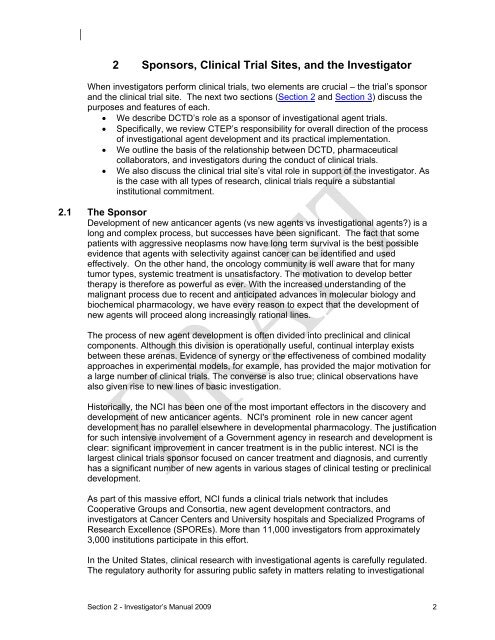A Manual for Participants in Clinical Trials of Investigational Agents ...
A Manual for Participants in Clinical Trials of Investigational Agents ...
A Manual for Participants in Clinical Trials of Investigational Agents ...
You also want an ePaper? Increase the reach of your titles
YUMPU automatically turns print PDFs into web optimized ePapers that Google loves.
2 Sponsors, Cl<strong>in</strong>ical Trial Sites, and the Investigator<br />
When <strong>in</strong>vestigators per<strong>for</strong>m cl<strong>in</strong>ical trials, two elements are crucial – the trial’s sponsor<br />
and the cl<strong>in</strong>ical trial site. The next two sections (Section 2 and Section 3) discuss the<br />
purposes and features <strong>of</strong> each.<br />
• We describe DCTD’s role as a sponsor <strong>of</strong> <strong>in</strong>vestigational agent trials.<br />
• Specifically, we review CTEP’s responsibility <strong>for</strong> overall direction <strong>of</strong> the process<br />
<strong>of</strong> <strong>in</strong>vestigational agent development and its practical implementation.<br />
• We outl<strong>in</strong>e the basis <strong>of</strong> the relationship between DCTD, pharmaceutical<br />
collaborators, and <strong>in</strong>vestigators dur<strong>in</strong>g the conduct <strong>of</strong> cl<strong>in</strong>ical trials.<br />
• We also discuss the cl<strong>in</strong>ical trial site’s vital role <strong>in</strong> support <strong>of</strong> the <strong>in</strong>vestigator. As<br />
is the case with all types <strong>of</strong> research, cl<strong>in</strong>ical trials require a substantial<br />
<strong>in</strong>stitutional commitment.<br />
2.1 The Sponsor<br />
Development <strong>of</strong> new anticancer agents (vs new agents vs <strong>in</strong>vestigational agents) is a<br />
long and complex process, but successes have been significant. The fact that some<br />
patients with aggressive neoplasms now have long term survival is the best possible<br />
evidence that agents with selectivity aga<strong>in</strong>st cancer can be identified and used<br />
effectively. On the other hand, the oncology community is well aware that <strong>for</strong> many<br />
tumor types, systemic treatment is unsatisfactory. The motivation to develop better<br />
therapy is there<strong>for</strong>e as powerful as ever. With the <strong>in</strong>creased understand<strong>in</strong>g <strong>of</strong> the<br />
malignant process due to recent and anticipated advances <strong>in</strong> molecular biology and<br />
biochemical pharmacology, we have every reason to expect that the development <strong>of</strong><br />
new agents will proceed along <strong>in</strong>creas<strong>in</strong>gly rational l<strong>in</strong>es.<br />
The process <strong>of</strong> new agent development is <strong>of</strong>ten divided <strong>in</strong>to precl<strong>in</strong>ical and cl<strong>in</strong>ical<br />
components. Although this division is operationally useful, cont<strong>in</strong>ual <strong>in</strong>terplay exists<br />
between these arenas. Evidence <strong>of</strong> synergy or the effectiveness <strong>of</strong> comb<strong>in</strong>ed modality<br />
approaches <strong>in</strong> experimental models, <strong>for</strong> example, has provided the major motivation <strong>for</strong><br />
a large number <strong>of</strong> cl<strong>in</strong>ical trials. The converse is also true; cl<strong>in</strong>ical observations have<br />
also given rise to new l<strong>in</strong>es <strong>of</strong> basic <strong>in</strong>vestigation.<br />
Historically, the NCI has been one <strong>of</strong> the most important effectors <strong>in</strong> the discovery and<br />
development <strong>of</strong> new anticancer agents. NCI's prom<strong>in</strong>ent role <strong>in</strong> new cancer agent<br />
development has no parallel elsewhere <strong>in</strong> developmental pharmacology. The justification<br />
<strong>for</strong> such <strong>in</strong>tensive <strong>in</strong>volvement <strong>of</strong> a Government agency <strong>in</strong> research and development is<br />
clear: significant improvement <strong>in</strong> cancer treatment is <strong>in</strong> the public <strong>in</strong>terest. NCI is the<br />
largest cl<strong>in</strong>ical trials sponsor focused on cancer treatment and diagnosis, and currently<br />
has a significant number <strong>of</strong> new agents <strong>in</strong> various stages <strong>of</strong> cl<strong>in</strong>ical test<strong>in</strong>g or precl<strong>in</strong>ical<br />
development.<br />
As part <strong>of</strong> this massive ef<strong>for</strong>t, NCI funds a cl<strong>in</strong>ical trials network that <strong>in</strong>cludes<br />
Cooperative Groups and Consortia, new agent development contractors, and<br />
<strong>in</strong>vestigators at Cancer Centers and University hospitals and Specialized Programs <strong>of</strong><br />
Research Excellence (SPOREs). More than 11,000 <strong>in</strong>vestigators from approximately<br />
3,000 <strong>in</strong>stitutions participate <strong>in</strong> this ef<strong>for</strong>t.<br />
In the United States, cl<strong>in</strong>ical research with <strong>in</strong>vestigational agents is carefully regulated.<br />
The regulatory authority <strong>for</strong> assur<strong>in</strong>g public safety <strong>in</strong> matters relat<strong>in</strong>g to <strong>in</strong>vestigational<br />
Section 2 - Investigator’s <strong>Manual</strong> 2009 2




